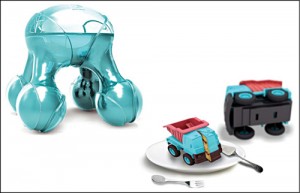This is considered a disruptive innovation because although several scientists have had success in building organs using varied techniques in the past, they have always been stumped by the lack of blood vessels. This recent development achieves precisely that, using 3D printing!
Picture perfect. One of the winning inventions at this year’s Innovation Days at the University of Wisconsin-Madison was Spectrom, an attachment for 3D printers that enables users to incorporate ‘seamless, on-demand colour’ into the 3D printing process. Developed by two chemical engineers, Spectrom is designed to work with fused deposition modelling (FDM) 3D printers, which are the most common amongst consumer printers due to their ease of use and relatively low cost.
Current FDM colour printing technology simply makes use of pre-dyed plastic filament, limiting opportunities for the user. Spectrom on the other hand delivers solvent dyes directly to clear plastic filament in a continuous, on-demand process. This allows the user to print colourful 3D models easily, just as we print colour pictures using an inkjet printer. The inventors think that colour-matched prosthetics is one of the most useful applications of Spectrom.

Currently, doctors mould parts such as noses and then have an artist paint them to match the patients’ skin tones. But, with Spectrom and a 3D printer, it is possible to scan someone’s face, build an exact face profile and easily print perfectly-matched parts.
3D printed skull helps patient regain vision and normal activity. Early this year, a team of Dutch surgeons led by Dr Bon Verweij successfully replaced the skull of a 22-year old with a custom-made, plastic, 3D printed skull. After a three-month observation, the doctors announced the success of the surgery in March. The 3D printing technology used was developed by Anatomics of Australia. The researchers said that similar surgical techniques could be used to treat several other bone abnormalities.
Beating hunger pangs, even in outer space. Several food printing solutions are in the market today, to print out food structures using raw material in powdered form. Today, most of them are busy churning out fancy stuff using raw materials such as cocoa powder and sugar. Like the figurine atop a wedding cake for example! However, there are also certain models that take protein powders or other nutrient molecules as input and print out balanced diets. Electrolux Design Labs’ Atomium 3D Food Printer, starts with nutrient molecules, and fuses them layer by layer to create customised nutritious foods in various shapes. The printer will apparently solve the problem of serving healthy food to kids.
NASA too is working on a solution to 3D print nutritious food for astronauts in space.
US start-up Modern Meadow is working on a 3D printer that is capable of printing raw meat. The process starts with stem cells from the animals. The cells are then made to multiply and, once they reach large enough numbers, they are placed in a cartridge to act as bio-ink. The ink is squirted out of a nozzle to create desired shapes, after which the bio-ink particles naturally fuse to form real living tissue similar to natural raw meat. The team is working to address quality and food safety regulations. Once the technology is ready for the market, it would consume 96 per cent less water and 45 per cent less energy than the meat production methods prevalent today, and also reduce greenhouse gas emissions from this sector by 96 per cent, according to the company.
This obviously is just the tip of the iceberg. With ongoing innovations in electronics and material sciences, newer 3D printing technologies and inks for the same are cropping up, making it possible to print not just models but real-life objects and even living tissues. What we still hope for is more user-friendly software to design and print objects so 3D printing will catch up amongst home users as well, rather than remaining the preserve of scientists, technologists and expert do-it-yourself enthusiasts.
The author is a technically-qualified freelance writer, editor and hands-on mom based in Chennai






